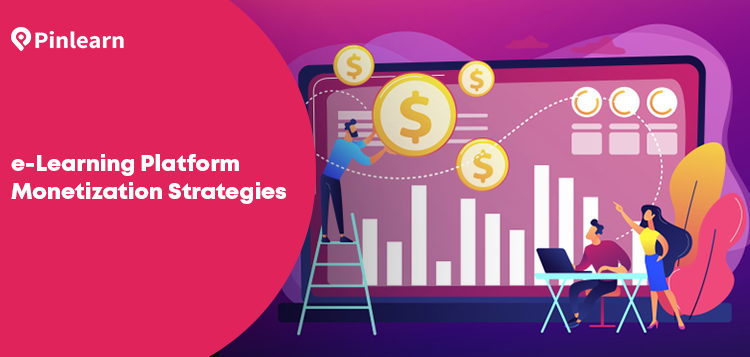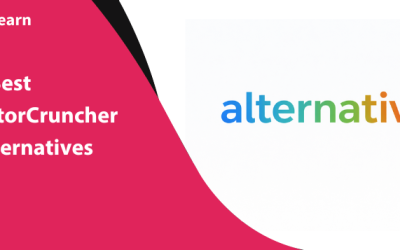E-Learning Platform Monetization: Strategies That Actually Work
Building a successful e-learning platform takes more than just power-packed content. Your expertise and the best content can’t replace an effective business strategy to master success.
Ultimately, revenue is the currency for running your e-learning business! How you structure your monetization model — courses, subscriptions, or ad revenue — decides your potential to scale and generate revenue.
We have outlined the most effective e-learning monetization strategies to script success. Learn how the business model works, its pros and cons, and how to choose the right one for your business growth.
So, are you ready to carve your business roadmap?
Why Should You Diversify Your Platform’s Monetization Strategies?
What’s your primary goal for your e-learning platform? Definitely, your e-learning platform’s success. But, you need a long-term strategy to keep your platform going.
Relying on a single revenue source is a mistake.
Here’s why diversification is the key:
Increased Profits
Exploring different monetization streams maximizes your revenue potential. Pay-per-courses might be your primary revenue stream. However, you can earn more from all-inclusive subscriptions plans and certifications.
More Engagement
What if learners have a single type of content to consume? They will visit your platform only when they need the specific content. Diverse content types broadens your audience reach (different learning style).
Drive Retention Rates
Customer churn is inevitable; you need to find ways to reduce it. Offer more value when you cater to different user needs and preferences.
Higher Growth Potential
With diverse revenue streams, you can easily scale your platform & build niche authority.
Broader Reach
Monetizing from courses, subscriptions, certifications, affiliate marketing, and ads helps to target a wide spectrum of audience.
7 Ways for Monetizing E-Learning Platforms
| Monetization Strategies | Pros | Cons |
| Pay-per-course | Easy to manage courses, learner flexibility, more sales | No revenue stability, marketing challenges, lower lifetime value |
| Subscriptions | Recurring revenue, easy management, easy promotions | Higher churn, delivering ongoing value, legal issues, |
| Advertising or Sponsored Content | Low entry barrier, additional income, build initial audience | Lower conversion, no steady income, influences brand perception |
| Certifications or Micro-certifications | Learner flexibility, Incentivize learning, bridge skill gap | Less predictable income, quality concerns, technical issues |
| Memberships | Recurring revenue, high customer life time, engagement & loyalty | Offer ongoing value, managing churn |
| Affiliate Marketing | Passive income, low initial investment, genuine recommendations, scalability | Lower conversion, unpredictable income, trust issues |
| Corporate and Enterprise Training | Enhanced productivity, higher revenue, expand business | Challenging to create curriculum, lack of on-job implementation, challenging to satisfy customers |
Strategy # 1: Pay-per-courses
Pay-per-course is one of the simplest ways to monetize your e-learning platform. As the name suggests, learners pay a one-time fee and get lifetime access to that course.
This could include a single course or an entire module. Learners purchase only the course they are interested in, which is great for those who want to enhance a skill or knowledge in a specific area. This model is also great for cohort-based courses that run for a few months.
Benefits
- Easy to manage courses
Pay-per-course is a simple model — once learners purchase courses, the job is done. You don’t need to worry about churn like subscriptions.
- Learner Flexibility
Learners only pay for the courses that actually meet their learning goals and needs.
- Boost Your Sales
Adding related upsells at checkout can easily earn you extra revenue.
- More Conversions
Pay-per-courses are affordable for users. One-time purchases convert better than recurring offerings.
Works Best for:
Skill-enhancement courses, evergreen topics, short-form courses, digital downloads, cohort-based courses
Cons:
- No steady income source
Predicting the number of users likely to opt for your course is a guessing game. Some months, the sales are great, and other times, they’re sporadic.
- Marketing is challenging
Each course is unique, finding a new promotional strategy for each is nerve-wracking.
- Lower lifetime value
Sometimes, customers are looking to enhance a specific topic or skill. Once they find the right course, they won’t return.
Examples:
⚡Related Reads:
Strategy # 2: Subscriptions
Subscriptions are an age-old technique for recurring revenue.
You can charge a monthly or yearly subscription and offer access to your product or service. It is one of the most powerful tools for keeping your learners glued to your platform.
Besides, providing fresh content additions every month keeps the learning journey continuous.
Coursera and Skillshare are two popular subscription-based platforms. Coursera Plus is the platform’s subscription service that includes access to courses, specialisations, projects, certifications, and more.
Benefits:
- Recurring Platform Revenue
The auto-renewed subscriptions offer a predictable source of income. It brings more financial stability to your e-learning platform.
- Easy Engagement
The exclusivity and ongoing value of subscriptions keep learners engaged. Whether it’s out-of-box ideas, product features, rewards, or events, learners feel valued and special.
- Less Intense Promotions
The high value perception of subscriptions makes learners more committed to your product or service. Moreover, the incentives and discounts easily offer an attractive deal to customers.
- Perfect for Multi-Faceted Learning
Subscriptions are perfect for learners looking to enhance multiple skills or an entire module.
Works Best For:
- Arenas like software development, health and wellness, and personal development
- Niche topics like coaching and consultation
- Course creators who have a huge audience and release frequent content
Cons:
- Higher Churn Rate
Some learners are bound to cancel their subscriptions midway through. Dealing with the churn drama involves building long-term relationships and keeping your content evergreen.
- Delivering Ongoing Value
Offering novelty in your offerings demands effort and plan. You need to blend content with exclusivity to keep your learners engaged.
- Legal Issues & Compliance
Dealing with legal considerations of a subscription website involves navigating tax laws, privacy regulations, contracts, etc.
- Subscription Management Challenges
Subscriptions are customer-centric business. You’ll have to deal with refunds, cancellations, upgrades, and even downgrades which can get tedious.
Examples:
Skillshare, Coursera, LinkedIn Learning
Strategy # 3: Advertising or Sponsored Content
One of the essential revenue sources of the freemium model is ad revenue. Find ads that are relevant to your target audience and platform. Decide on ads that align with your educational mission.
Try text ads, banner ads, and even video ads. Embed them within lessons and sidebars, in a way that it doesn’t interfere with learning.
Use Google AdSense or learning ad networks like 7Search PPC for high ROI.Measure your ad performance with impressions, conversion rates, and clicks.
Benefits:
- Low Entry Barrier
The basic version of e-learning platform is available for free, hence learners would easily sign up to the platform.
- Additional Income Source
Besides monetizing from courses and subscriptions, ad spaces offer you additional revenue. A high website traffic is bound to bring in more ad conversions.
- Finance Free Content
While learners get free content access, platforms can still monetize themselves with ads.
- Great For Building an Initial Audience
Are you struggling to attract your learners? Ad-based e-learning platforms that offer free content access and are an easy way to build your audience initially.
Works Best For:
New e-learning platforms building their audience and credibility
Cons:
- Lower conversion to premium model:
Transforming free users into actual customers is challenging. Users might stick to the free version or leave the platform altogether.
- No steady source of income:
Unlike subscriptions and courses, there’s no steady income source. Your ad revenue is dependent on conversions and clicks, which is highly variable.
- Affect Brand Perception:
Embedding too many ads on your website affects website credibility and perceived brand value.
- Influences user experience:
Ads are often irrelevant and intrude the user’s privacy — major turn off.
Examples:
Khan Academy(Donation-based), Alison(ad-based), GeekBrains
Strategy # 5: Certifications & Micro-Credentials
We’re in an age where skills and training matter more than ever! A great way to monetize your e-learning platform is to offer the basic course access free and charge for certifications.
Further, you can incentivize students to complete their courses. Even professionals can validate their skills and share the certificate in their network. Certifications offer a great start for new professionals breaking into the industry.
Micro-certifications are a vouched approach for learners to build their skillset. It includes learning modules, quizzes, and final assessment. You can easily integrate a certification add-on if you’re on Learndash LMS.
Price your certifications based on the following:
- Quality & depth of exam
- Exam format
- Competitor analysis
- Technology involved
Benefits:
- Learning flexibility:
Learners have the freedom to choose their preferred course and build up their skills.
- Incentivize learning
Certifications are a great way to encourage learners to complete courses and build their portfolio.
- Bridge the skill gap
The skill credibility aids in career advancements or role transitions. It’s proof of a learner’s competency in a specific area.
- Upselling & course-bundling opportunities
You can create modules or packages of courses and include a certification at the end. Also, you can upsell related courses and earn additional income.
Works Best For:
Professional certifications like IT, business, project management, or specialized skill courses
Cons:
- Less predictable revenue
Unlike subscriptions, certifications are a less predictable source of income. And every course demands a different kind-of-marketing, increasing the promotional expenses.
- Accessibility and technical issues
Learners require specific softwares and technologies for completing certification. Also, technical glitches or limited technology could hinder certification programs.
- Quality concerns
Learners often prefer certifications from credible online sources. You might have to address questions from learners on your certification’s credibility.
Example:
Coursera (free audits but charges for certification), Alison
💡 Pro Tip: Partnerships with accredited organizations or universities can increase the credibility of your certifications. This could attract more enrollments and build your authority.
Strategy # 6: Memberships
Need another way for recurring income? Memberships are a good bet! They are similar to subscriptions, but adopt a tiered pricing approach.
Create a membership site where members can access exclusive content for a monthly or yearly fee. You can create unique tiers with different levels of access.
These tiers include access to premium content, events, private coaching, digital products, etc. Patreon, Memberful, Kajabi, Thinkific, are excellent platforms for selling memberships.
Memberships are powered by one crucial element – resounding communities. This includes a shared space for members to share, collaborate, and network.
Benefits:
- Recurring Revenue
The membership fees help build a brand and create valuable content for members.
- Engagement and Customer Loyalty
Premium content, live events, and community spaces make members feel valued and appreciated. This builds your empowering tribe of like-minded people who bleed loyalty.
- High Customer Life Time
Retaining your members for the long-term is a constant quest. Membership sites offer valuable content experiences extending the overall lifetime of customers.
Works Best For:
Niches like fitness, language tutoring, creative & lifestyle niches, corporate training
Cons:
- Difficult to Offer Ongoing Value
Unlike one-time sales, there’s an ever-increasing need for frequent content updates.
- Managing the Churn
With an easy-cancellation process, members can cancel membership anytime. This calls in the need for strong retention strategies.
Examples:
MasterClass, LinkedIn Learning, PluralSight
Strategy # 6: Affiliate Marketing
The next monetization strategy doesn’t need you to have your own e-learning products or services. Yes, affiliate marketing helps you earn a commission for the successful sale of referrals or links.
Your e-learning platform can partner with relevant bloggers, course creators, or influencers. The key is to choose ones that align with your platform’s niche and area of expertise.
Consider factors, such as platform reach, expertise,niche relevance and engagement for selection. On clicking the links, the audience gets redirected to the affiliates’ website. While affiliates benefit from enrollments, your platform rakes in more revenue.
Benefits:
- Earn Passive Income
Earn from affiliate programs even while you’re asleep. No hard sells or active promotions, just embed the link strategically in your website.
- Low Initial Investment
No need to create products or services. All you need is an e-learning website to promote your affiliate programs.
- Provide genuine recommendations
Audiences benefit from genuine recommendations, whether it’s an exclusive deal or a trusted resource.
- Scalability
You can promote multiple affiliates simultaneously and pump in sizable revenue to your platform.
Works Best For:
Platforms with broad catalogue of courses, recurring revenue, high commissions, etc.
Cons:
- Low commission rates
Many affiliate programs offer low commission rates, significantly lowering your platform revenue.
- Trust and reputation risk
The audience might not trust your recommendations if they are not popular enough.
- Unpredictable Income
Affiliate programs operate on the pay-per-performance model. You can’t always earn an expected source of income despite putting in your maximum efforts.
Examples:
Strategy # 7: Corporate and Enterprise Training
With the vying competition, businesses are on a constant quest to create a trained workforce. You can create quality training programs and workshops based on business requirements and goals.
Offer different pricing models: pay-per-session, flat rates, pay-per-learner, or even subscriptions. Corporates typically use training programs to increase productivity, skill-building, onboarding, etc.
It involves well-rounded learning with webinars, micro-certifications, mini-courses, assessments, etc.
Benefits:
- Enhance Productivity & Performance
Modern corporate programs focus on skill-building, innovation, change adaptability and boosting productivity.
- Charge Higher Fee
E-learning platforms can charge premium pricing given the significant ROI to businesses, value gained, etc.
- Expand Business
If you wish to scale your business beyond students, enterprise training is the right bet!
Works Best For:
Areas like professional development include IT, leadership, HR, etc.
Cons:
- Challenging to Create a Curriculum
Curating a curriculum for employee training is quite different from academic learning. Only when you understand the business needs and goals fully does it lead to the right outcomes.
- Satisfying Employee Expectations
Aligning your training program with manager and employee expectations is hard work.
- Lack of On-job Implementation
Often, employee training programs fail to reflect on performance and fade away, as do box-ticking exercises.
Examples:
Udemy Business, Coursera for Business
How to Choose the Right Monetization Model?
So, which revenue model best aligns with your business?
Picking the right monetization strategy for your e-learning platform could be confusing. There’s business goals, user behaviour, website design, etc., that you need to consider.
1. Define Your Business Goals & Challenges
First, define what you plan to achieve with your e-learning business.
Common Objectives:
- Increased revenue
- Personalized learning & engagement
- Upskilling and reskilling
- Customer retention and onboarding
- Building brand awareness
Challenges:
- Budget Limitations
- Technical infrastructure – tools & software
- Learner engagement
- Content quality & relevance
- Knowledge Retention
Defining your business goals beforehand helps to strategically plan & implement your e-learning business.
2. Understand Target Audience
Your ultimate goal is to offer personalized learning experiences for your target audience.
Thus, a deep dive into user behaviour is essential. Understand the features and experiences they like the most, and ones that repel them. Creating personas helps to define an e-learning business targeting specific customer segments.
Ask these questions to create detailed learners’ personas:
- Who is your target audience (e.g., students, mid-managers & senior leaders, or career professionals)?
- What are their goals and objectives — improving knowledge, skill-building, or certification?
- What are their major learning challenges?
- Do they prefer self-paced or instructor-led learning?
- Which features and services aid learning?
Creating learner personas helps to offer a more powerful learning experience.
3. Choose a Revenue Stream that Aligns with Your Content
What kind of content does your e-learning platform offer? Cohort courses, one-to-one tutoring services, or training videos?
Choose a befitting monetization strategy that streamlines your content in the best way. For example, you can monetize premium courses best with subscriptions. For a well-rounded learning experience, including courses, webinars, and communities, memberships work like a charm.
This ensures you provide the perfect learning experience and earn the best value for your money!
4. Your Website Design & Feature Matters
Right technology plays a crucial role in scaling your e-learning business model. This means the right platform features and tools to implement them.
Here are a few questions to consider:
- Does your LMS support your monetization model?
- Does it support integrations like payment gateways, video conferencing tools, and CRMs?
- Is your learning platform scalable to accommodate more traffic and data?
Select a scalable LMS to ensure you can seamlessly integrate the monetization strategy into your e-learning platform.
Pinlearn is an all-in-one, readymade solution to build your e-learning business. From creating and selling courses to multiple monetization channels and seamless marketing, make the most of your e-learning business.
5. Create Pilot Programs
There’s no one-size-fits-all approach that works for a specific platform type or content. Of course, we can take cues from successful learning platforms. But their golden formula doesn’t guarantee you success!
The goal is to find your optimum price point. More users, higher engagement and serves = better revenue milestones.
Collect data-driven insights on content, engagement levels, and delivery methods.
For instance, start with one-time purchases. Later, offer monthly subscriptions to learners who need to learn from diverse niches.
📝Pro Tip: Run a pilot program. Assess your offerings for a small audience. This helps to incorporate feedback and refine your offerings before actual implementation. Analyze the learner engagement levels and completion rates.
Best E-learning Platform Types for Implementing Monetization Models
E-learning Platform Type Monetization Strategies
| E-learning Platform Type | Monetization Strategies |
| LMS | Pay-per-course, subscription models, Certificates freemium models |
| Membership Site | Memberships, Course-bundling & Upselling |
| Online Course Marketplaces | Pay-per-course, Subscription, Certificates |
| Social Learning Platform | Subscriptions, Sell E-learning content through online store |
| Tutoring Marketplaces | 1-on-1 Live sessions, Subscriptions |
| Corporate Training Platform | Self-paced courses, certifications, cohort courses |
How to Measure Online Engagement & Performance Metrics?
Is there a way to know you have zeroed in on the right monetization strategy? A set of powerful metrics. But there’s a catch here — different metrics work for different monetization strategies.
Here’s a list of metrics to keep an eye on:
- Courses – Course completion rate, skill acquisition, revenue from courses
- Subscriptions – Customer Lifetime Value, Churn Rate, Monthly Recurring Revenue,
(Use Google Analytics, Chart Moghul)
- Freemium – Conversation Rate, Average Revenue Per User
(Use Google Analytics, MixPanel)
- Ad-Based Revenue Model – Click-Through Rate (CTR), Engagement Rate, Cost Per Mile (CPM)
(Use Google Analytics, Google Ads Manager or AdMob)
- Course-Bundling – Course Completion Rates, ROI, Customer Satisfaction
- Memberships– Monthly Recurring Revenue (MRR), Churn, Engagement, Customer Lifetime Value
- Affiliate Marketing – Clicks, Conversion Rates, Sales
- Corporate and Enterprise Training – Completion Rate, Training ROI, Performance Post-Training
Relevant Case Studies of Monetizing E-Learning Platforms
Duolingo
If you are in the e-learning realm, you might be familiar with Duolingo‘s beloved green mascot Duo. One of Duolingo’s well-played marketing tactics!
Beyond acing the marketing game, the language learning platform has a stellar freemium business model. It offers the basic platform features for free, building a massive audience base. And monetizes from its premium version and in-app purchases.
Launched by Luis von Ahn in 2012, Duolingo became an instant hit among users thanks to its guilt-tripping streaks, quirky brand voice, and unique brand proposition!
Duolingo’s Official Website
Impact & Reach
The platform has 37 million active monthly users and a $7.7 billion valuation. It provides over 100 courses in 40 different languages. It has been one of the leading educational apps on the Apple store for over a decade.
Monetization Streams:
Duolingo monetizes from:
- Running targeted ads
- Super Duolingo Subscription (includes offline access, ad-free lessons, progress tracking)
- Duolingo for Business
- In-App Purchases
Coursera
Coursera has pioneered as a massive open online course with a remarkable $694.7 million in revenue. It offers pre-recorded lectures to learners in diverse arenas. This includes business and information technology, health, personal development, etc.
While learners can audit the course for free, they must pay for certifications. The platform offers courses, degrees, professional certifications, and master track programs.
Coursera Official Website
Impact & Reach:
The platform offers over 10,000 courses in collaboration with 350+ leading universities and companies. Over 4,300 companies use Coursera for training programs. And an astounding 175 million learners registered on the platform.
With its amazing reach in consumer, business, and university markets, the online platform made $371.4 million in profits.
Monetization Streams:
So, how did Coursera achieve this astounding feat?
- Coursera Plus Subscription – Unlimited Course Access in different disciplines
- Coursera for Business – Employee training programs & skill-building
- Universities – Offers university-led degrees & certifications
💡 Related :
Conclusion
Choosing the right monetization strategies is your ladder to success. Consider factors like target audience, content, business goals, technology, and scalability.
Test and iterate different monetization models to find the right fit! Track different metrics that determine your platform’s success. We have covered all the best e-learning monetization strategies for your long-term success!
FAQ-Related to E-Learning Platform Monetization
1. How to make money with e-learning?
Following are different ways to earn money on e-learning platforms:
- Create & Sell Courses
- Offer Subscriptions
- Paid Certifications
- Upselling & Cross-selling
- Advertising and Sponsored Content
- Membership Programs
- Affiliate Programs
- In-app purchases
2. Is ad monetization a good strategy for e-learning platforms?
Yes, ad monetization is an excellent monetization strategy. It’s great for diversifying your revenue source, earning with minimal investment, and hosting sponsored content.
3. How do I decide between one-time courses and subscriptions?
Consider factors like target audience, platform features, and your e-learning content to choose between one-time courses and subscriptions.





